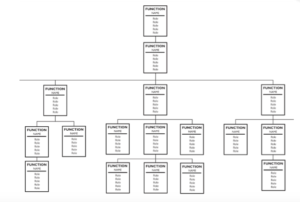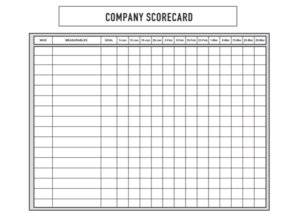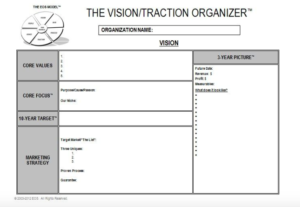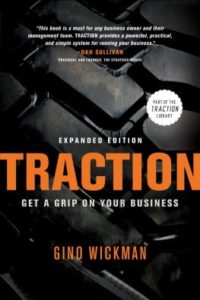In the latest of our Northern Review series, Niall Crozier summarises Gino Wickman’s process to help SMEs get thing done.
Traction is essentially a framework of (not very catch-ily named) templates and meetings to clarify an SME’s vision, and execute it. Leaning heavily on the work of Jim Collins, Patrick Lencioni, Michael Gerber and Dan Sullivan, Gino Wickman aims his method at business leaders who:
- Lack control over their businesses, and instead have their time controlled by their businesses; and/or
- Are not on the same page as their customers, employees, partners, or suppliers; and/or
- Have growth or profitability challenges, despite having ‘tried everything’; and
- Are willing to be open minded, vulnerable and growth orientated, taking risks, discussing difficult issues and making difficult decisions.
I don’t have time to read it — what are the book’s main messages?
Wickman’s method emphasises six components:
- Vision – Help people ‘See what you mean’: Together with your leadership team, define your vision, in terms of core organisational values, and a single, focused target to point everyone in the business toward;
- People – The right people in the right seats: Select talent based on both how they align to your core values, and whether they ‘get’ what’s required, ‘want’ to do the job, and ‘can’ deliver (have the capacity and capability);
- Data – What gets measured gets done: Create a concise scorecard of objective measures of the business’ performance, check it regularly, and ensure the right people are accountable for the right metrics;
- Issues – Rigorously identify and prioritise obstacles: Be transparent about the challenges you are facing, but approach solving them in a focused way rather than all at once;
- Process – Document ‘your way’: Articulate the approach you take simply, to allow scalability and efficiency. With each stage of growth, and additional level of simplification is required;
- Traction – Execute well: Work in a disciplined 90 day cycle, maintaining accountability and momentum to reliably deliver a small number of crucial steps each quarter.
However, in practice, he recommends implementing them in the order shown below, beginning with the leadership team, then those who report to them.
 Step 1: Getting the right people in the right seats
Step 1: Getting the right people in the right seats
This begins with building and maintaining a true leadership team, who:
- Are better than the overall leader in their field;
- Are credible, able to co-define the vision, able to take initiative by predicting upcoming needs, and to be accountable for the execution of delivery;
- Delegate well; and
- Have a systematic approach, bringing structure and simplicity to how their teams work.
The primary tool for determining the ‘right seats’ is to build an ‘accountability chart’, rather than a standard organisational chart. It outlines the activities required to run the organisation, and who is responsible for delivering it; as such, one person may be assigned to multiple roles. Below the primary leader(s), are typically three core functions, comprising the rest of the top team:
- A demand / revenue generation function e.g. Sales & Marketing;
- An Operations function, covering the activities are required for delivering the organisation’s product(s) and/or services e.g. Manufacturing; and
- A Finance & Administration function, responsible for the payment and receipt of money.
Like an org chart, each lower layer shows a more granular breakdown of accountability. The layer below the three core functions should total no more than 7 ‘accountabilities’ e.g. Sales & Marketing has both a Marketing and a Sales role.
Wickman views leadership above the core functions as composed of two different skill-sets (and therefore accountabilities):
- Integrator role: day to day running of the organisation, resolution of tension between the three core functions, disciplined execution; and
- Visionary role: long term strategy, innovation / new product development, partnerships, key customer relationships.
Finally, identifying the ‘right people’ requires evaluating your talent based on:
- Whether the role they have in the accountability chart is within their ‘sweet spot’; they must ‘get it’, ‘want it’, and have the capability and capacity to do it;
- The extent they share your core values (which will be articulated in your vision). If you have five core values, don’t retain people who are ‘neutral’ on any more than three of these, or ‘negative’ on any of them.
 Step 2: Gaining ‘Traction’
Step 2: Gaining ‘Traction’
Getting things done sustainably requires instilling organisational discipline. In the ‘Traction’ method, this is primarily derived from two components – ‘Quarterly Rocks’ and the ‘Meeting Pulse’.
‘Rocks’ are significant objectives or milestones for the organisation to hit. These are set out by quarter on the basis that humans can only focus for so long. Each one has a single named owner to ensure accountability. ‘Rocks’ exist at differing levels in the organisation; while each of the leadership team may have a few rocks on behalf of the organisation, their team members may each have a Rock on behalf of the department. The key is focusing on delivering a small number, well.
The ‘Meeting Pulse’ is a predictable rhythm of (annual, quarterly and weekly) meetings and agendas, with an accompanying ‘to do list’, and the ‘Issues solving track’ for tackling problems head on. This is because when people know they’ll be checked up on, they do things. While it introduces a context for systematically identifying, discussing and solving problems, an accompanying culture of trust is required for people to feel comfortable calling issues out. Issues range from strategic, company-wide challenges, to highly specific departmental considerations, but the approach is the same. The conclusion – either an action to do, agreement to be communicated, or more research to be conducted – is written down and assigned (similar to a ‘requirement’ or ‘user story’) bringing clarity in the process.
 Step 3: Measuring what matters, with a company scorecard
Step 3: Measuring what matters, with a company scorecard
In Traction, a weekly scorecard is used to drive objective decision-making, promote accountability, stimulate proactive problem solving, identify patterns and challenge assumptions. Using a scorecard caters for the natural human desire to be able to measure progress, but also saves time and worry by regularly measuring the numbers that matter – and only those numbers.
The scorecard is composed of 5-15 leading – rather than lagging – indicators, on a rolling 13 week basis, measuring activity that predicts your future P&L. Each number has an accountable owner, and a RAG rating based on a target tied to the company’s one year plan.
In the longer term, Traction promotes everyone in the organisation ‘having a number’. This ‘measureable’ is tailored to reflect how each role contributes to the overall vision, and is intended to:
- Set healthy, objective expectations and accountability between managers and their direct reports, bringing clarity that ‘The right people in the right seats’ should be receptive to; and
- Tap into competitive dynamics, encouraging collective responsibility where means people make others lift their game, to hit targets together.
 Step 4: Setting the organisation’s vision
Step 4: Setting the organisation’s vision
This part of the Traction approach aims to create a tangible, visible direction for the organisation: “If people can see something, they’re more likely to believe it will happen.” The vision template sets out an interlocking sequence of choices for the leadership team to work through:
- Core Values: These are the principles matter most to the leadership team, and consequently are the identifiers of like-minded people. Wickman suggests choosing the ‘3 people in the company would you clone’, and selecting the values they represent;
- Core focus: Also called a ‘mission statement’, ‘winning aspiration’ or ‘essence’, this articulates the company’s reason for being – its purpose / cause / passion – in 3-7 simple words, and sets out its niche;
- 10, 5 or 20 year target: Known as a ‘Big Hairy Audacious Goal’ by Jim Collins, this larger than life stretch goal sets the organisation’s long range direction;
- Marketing strategy: This recognises that the organisation can’t be all things to all people; instead, in order to do more of the right business, the target market is defined in terms of demographic, geographic and psychographic factors. ‘3 uniques’ are chosen to articulate the differentiated value proposition to the target market. Finally, a guarantee (e.g. Dominoes’ ‘30 minutes or it’s free’) pinpoints a service or quality problem the target market has, and solves it, forcing the organisation to deliver and putting its customers at ease;
- 3 year picture: This sets specific targets for revenue, profit, and other key measurables. A qualitative description of what the organisation will look like in that timeframe is also set out, (sometimes articulated as a high level operating model);
- One year plan: In addition to a one-year version of the 3 year picture, this plan sets out 3-7 specific, measurable, and attainable goals for the year, and the projected budget to support them;
- The vision is then earthed with a list of the ‘Quarterly Rocks’ that need to be delivered as a result, and a list of the organisation’s ‘issues’ – the obstacles and constraints that could prevent the vision being delivered;
- Finally, the vision needs to be communicated (on average 7 times before it’s understood), so that people understand how they fit into contributing to it. The quarterly ‘all hands’ in the ‘Meeting Pulse’ (see above) allows this to be shared, in terms of ‘Where you were’, ‘Where you are’ and ‘Where you’re going’.
 Step 5: Systematising and implementing key processes
Step 5: Systematising and implementing key processes
As Wickman points out, “Nothing can be fine-tuned until it’s consistent”. The documentation of the company’s processes is key to improving time and cash costs, efficiency, scale and control. The aim is to create a ‘franchise prototype’, paving the way for the organisation to run without you, as well as creating a ‘common language’ for your people. This ‘turnkey system’ allows leaders to devolve leadership and keep those who receive it accountable.
At the highest level, this requires an articulation of the organisation’s overall ‘Way’, for use as a marketing or training tool. Using 3-7 major steps, with ~5 talking points under each step for sales people, trainers etc. to use, this gives confidence to prospects and recruits that you’ll get results.
At a more detailed level, a handful of core processes (on average about 7), work together to form the backbone of an organisation. These should be identified, agreed on, and documented with consistent language. These may include processes relating to marketing, sales, operations, customer retention, HR, accounting etc. Each departmental head documents the key aspects of what actually happens in each process within their team, although the Integrator owns the overall project.
From there, the processes can be improved, streamlined, automated using technology, and better controlled using checklists. Where a problem occurs, it becomes easier for managers to troubleshoot, identify and solve issues, while the process can subsequently be tweaked to consistently improve future outcomes.
At this stage, a programme of change management and retraining is needed to ensure everyone then implements the processes. A further ‘circle of life’ diagram may be useful for showing each person how each process fits together and how everyone works for each other.
I get the idea, is it worth a read?
Traction doesn’t claim to be the best ‘operating system’ for your organisation, nor are any of its concepts particularly revolutionary. However, its emphasis being practical, and its focus on disciplined execution, is helpful if you’re struggling to get things done.




